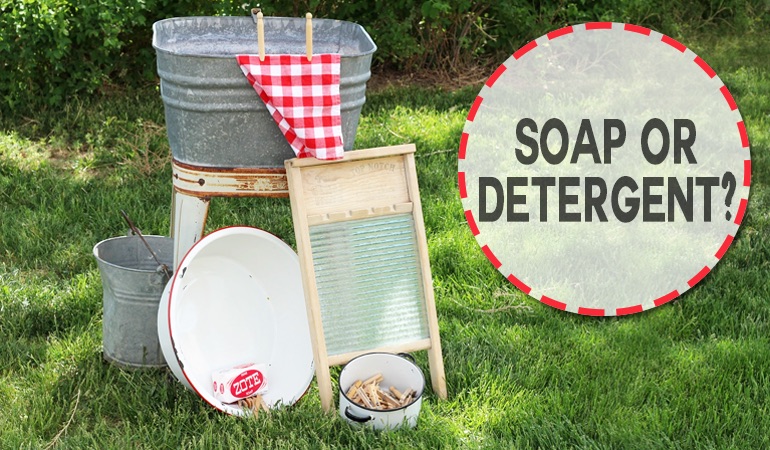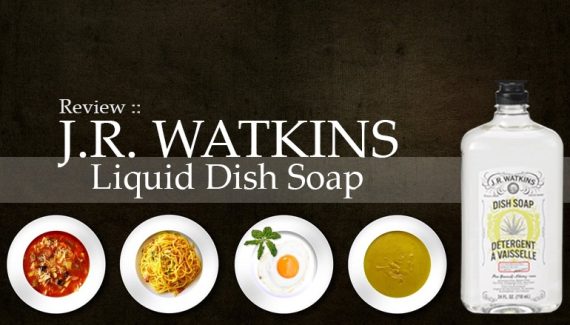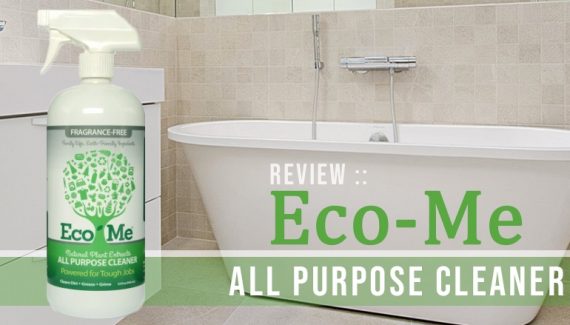Safe Household Cleaning is reader-supported. All reviews are independent and any products reviewed are purchased by the site owner. To help fund this model, some of the links on the site are affiliate links. If you decide to make a purchase from one of these links, this site will receive some commission. At no cost to you. It helps keeps this place running. Learn more
A decade or so ago, the difference between a soap and detergent was redundant when it came to a cleaning product. Virtually every product available was a detergent. However, in recent years, soaps are making a comeback.
The question is why?
To answer that question, we must first delve into the difference between a soap and a detergent.
The terms ‘detergent’ and ‘soap’ are often used interchangeably, and the two are similar – both act as surfactants, making dirt easier to disperse and wash away. Each has slightly different chemistry [1, 2, 4]:
- Soaps (e.g. sodium stearate) – fatty acids, normally derived from animal or plant sources. The ‘-carboxyl’ group of fatty acids can react with calcium or magnesium in hard water to form an unpleasant ‘soap scum’.
- Detergents (e.g. sodium lauryl sulfate, sodium dodecylbenzenesulfonate) – normally synthetic from propene, can have complex hydrocarbon structures (e.g. benzene rings). They are less likely to react with ions in hard water, and so do not form a ‘soap scum’.
Generally, soaps are used in shampoos, body washes, and hand washes because there is a huge excess of water, so soap scum is just washed away.
However, commercial washing products (powders and liquids) were developed to use detergents to reduce soap scum. This scum can grey clothes and buildup in washing machines.
Unfortunately, the synthetic detergents came at their own cost. The synthetic detergents certainly the earlier ones, had a tendency to cause contact dermatitis when they came into contact with sensitive skin. In addition, there have been many reported biodegradable and toxic concerns about a number of the synthetic detergents. What doesn’t help matters is many manufacturers are still not disclosing their cleaning product ingredients, so there are often trust issues with a product labeled with “anionic surfactants” as opposed to the actual ingredient.
So in recent years, we’ve seen a reemergence in soap based household cleaners. And there are ways to soften the water by adding ingredients such as ‘soda ash’ (sodium carbonate) to help soften water, reducing soap scum.
I like the sound of the natural approach – how are soaps made?
Humans have been making soaps using the same underlying technology for centuries. All soaps start from animal or plant fats (triglycerides), which are made up of fatty acids and glycerin. The choice of fat and its ratio of saturated to unsaturated fatty acids will vary the texture of the resulting soap (e.g. mild, firm). Commonly used fats are listed below.
| Animal Fats | Plant Fats | ||
| Raw Animal Fat | Resulting Fatty Acid | Raw Plant Fat | Resulting Fatty Acid |
| Tallow (beef fat) | Sodium tallowate* | Palm oil | Sodium palmate |
| Lard (pig fat) | Sodium lardate* | Palm kernel oil | Sodium palm kernelate |
| Laurel oil | Sodium laurate | ||
| Olive oil | Sodium oleate | ||
| Coconut oil | Sodium cocoate | ||
[The sodium salt can be changed to potassium by using potassium hydroxide, see below.]
The ‘soap’ or ‘surfactant’ action of soap is due to fatty acids. To liberate fatty acids, the raw triglycerides need to be heated with a strong alkali. Both sodium hydroxide (lye or caustic soda) and potassium hydroxide (potash) are commonly used as the strong alkali to make solid and liquid soaps respectively. The reaction forms fatty acid salts, which vary in texture depending on the alkali:
- Potassium fatty acid salts (e.g. potassium hydroxide + olive oil = potassium oleate) – these soaps are generally softer and can be liquids (e.g. hand soap).
- Sodium fatty acid salts (e.g. sodium hydroxide + coconut oil = sodium cocoate) – these soaps are generally harder (e.g. bar soaps).
[Note: Both sodium and potassium hydroxide are harmful irritants (pH=13). Soap that is properly made uses less alkali than necessary, to ensure none remains in the final product. Finished soaps normally have a pH of 9-10, and contain no potassium or sodium hydroxide]
So how are detergents manufactured?
Detergents are normally synthetic, manufactured from refining propene (a byproduct of crude oil). These were first produced due to a lack of animal and product fats during the World Wars. There are many types of detergent, and their surfactant action is more complex than soaps. Detergents can be categorized depending on the chemical mechanism in which they emulsify, with common examples including:
- Non-Ionic (e.g. alcohol ethoxylates)
- Anionic (e.g. sodium alkyl sulfate)
- Amphoteric (cocamidopropyl betaine)
Much like soaps, if detergents are properly produced they should not contain any remnants of the refining process. This can be more difficult to achieve and test for (not as simple as taking the pH), and so there is concern that many commercial washing detergents contain harmful and carcinogenic contaminants such as 1,4-dioxane and formaldehyde.
I’d like to buy a soap based cleaner – how do I spot it on the label?
Quite often you’ll see a reference to Sodium Hydroxide or Lye and an oil or fat. If you see those listed, it’s a good chance you’re looking at a soap based cleanser.
An alternative, particularly in liquid cleansers, is to look for Potassium Hydroxide with an oil or a fat.
Alternatively, manufacturers will label the actual resulting saponified oil in their ingredients, and the name of this depends on the oil actually used.
For example:
- Sodium palmitate (Lye and Palmitic Acid)
- Sodium stearate (Lye and Stearic Acid)
- Sodium oleate (Lye and Oleic Acid)*
- Sodium cocoate (Lye and coconut oil)
- Sodium palmate (Lye and palm oil)
- Potassium palmitate (Potassium Hydroxide and Palmitic Acid)
- Potassium stearate (Potassium Hydroxide and Stearic Acid)
- Potassium oleate (Potassium Hydroxide and Oleic Acid)*
- Potassium cocoate (Potassium Hydroxide and coconut oil)
- Potassium palmate (Potassium Hydroxide and palm oil)
Note, Sodium Oleate can originate from oleic acid found in lard or olive oil. The only way to differentiate from these products is to look for soaps listed as ‘vegan’ or ‘animal product-free’. An alternative is soaps that use responsibly sourced plant-based ingredients, like sodium cocoate sodium palmate.
Another common means of labeling soaps is to just refer to Saponified Oil. Unfortunately, there’s no way of telling what kind of oil was used. For cleaning purposes, it shouldn’t matter too much. However, for vegetarians or vegans, you’ll need to look for the vegan label to be sure.
How are detergents made?
Detergent ingredient labels are generally easier to understand but lack the detail of soap washing products. As with the formulations listed above, washing detergents will normally only list ‘anionic surfactants’ or ‘nonionic surfactants’. Some manufacturers provide more specific information on their website, but there is no other way to determine the composition – particularly frustrating for those with allergies to some detergents. Hence the recent trend in soap-based cleansers.
So what is better, a soap or detergent?
This really depends on personal preference. I have really sensitive skin, so tend to buy soap based cleaners. However, what’s most important to me is the manufacturer discloses the ingredients, and I can make a judgment from there. There are some amazing detergent based cleansers out there. And, there are a number of products that contain both soap and detergent. As long as the product discloses the ingredients and I’m not irritated by the ingredients, I’ll often buy it.
But that’s only my opinion. How do you choose yours?
References
[1] Smulders, E., von Rybinski, W., Sung, E., Rähse, W., Steber, J., Wiebel, F., & Nordskog, A. (2007). Laundry detergents. Wiley‐VCH Verlag GmbH & Co. KGaA
[2] Bajpai, D. (2007). Laundry detergents: an overview. Journal of OLEO Science, 56(7), 327-340.
[3] Unilever. (2018). Persil Products. www.persil.com [Accessed: 6/2/18]
[4] American Cleaning Institute. (1994), Soaps and Detergents. www.cleaninginstitute.org [Accessed: 6/2/18]



No Responses Yet